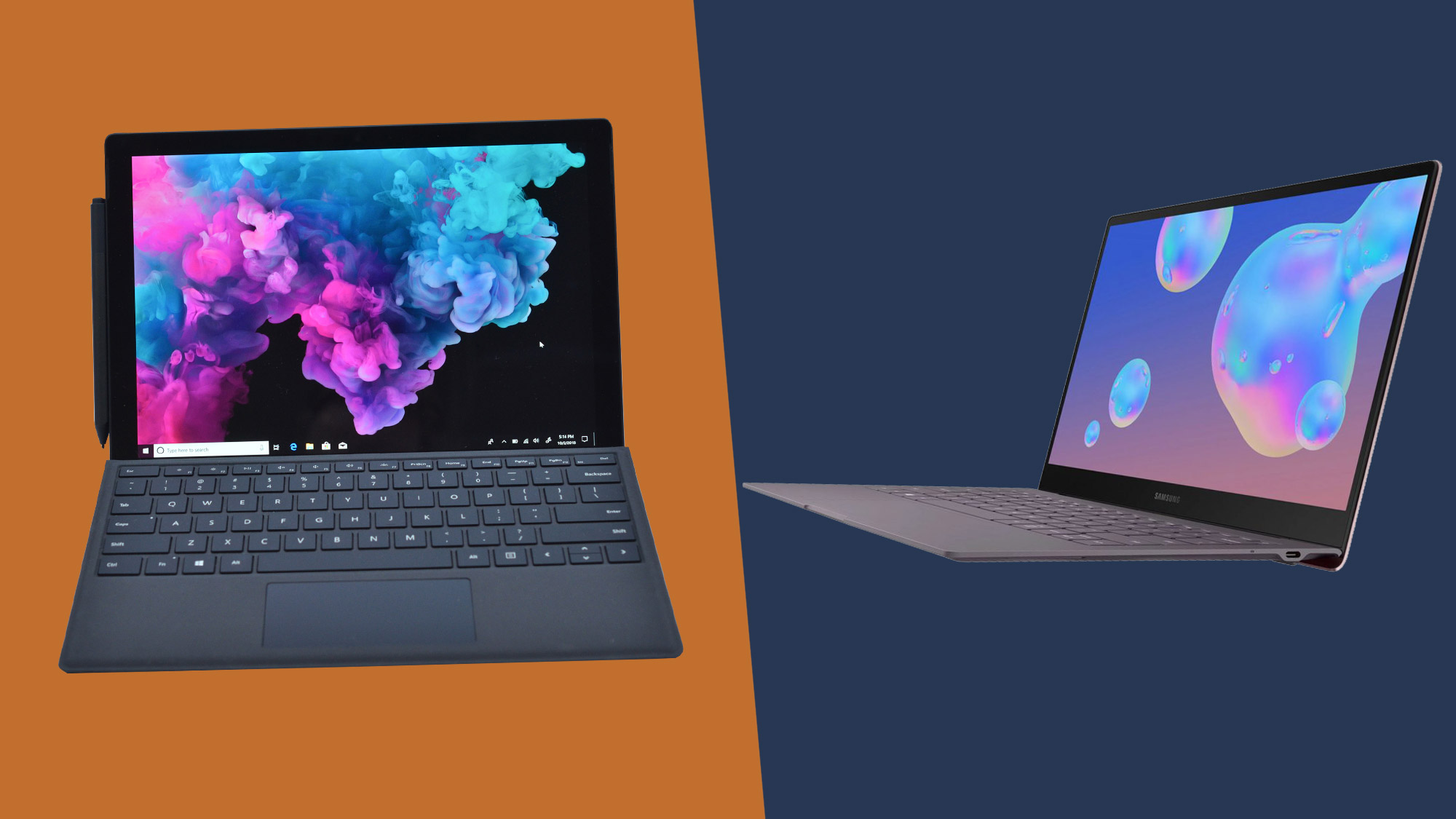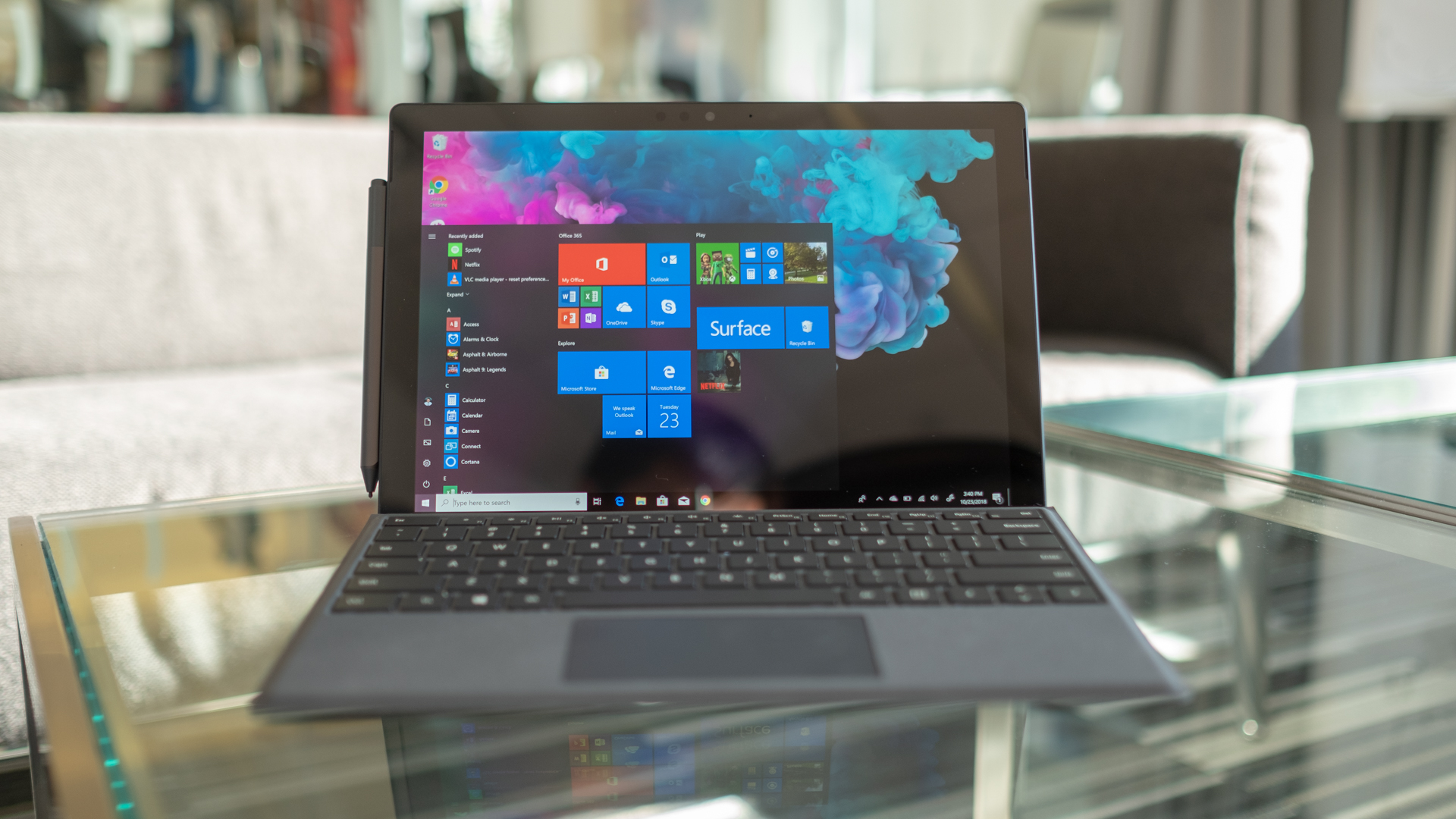Samsung Galaxy Book S vs Microsoft Surface Pro 6
Can Samsung’s new laptop hit Microsoft where it hurts?

Samsung surprised us all with the recent reveal of the Samsung Galaxy Book S, its latest notebook that aims to redefine what we can expect from a Windows 10 laptop – while taking aim at the likes of Microsoft’s Surface Pro 6.
The Surface Pro 6 is Microsoft’s latest Windows 10 laptop/tablet hybrid, and it’s an excellent showcase for the operating system, with a stylish design, thin and light feel and some impressively powerful components considering the size.
It’s exactly the sort of device that Samsung wants the Galaxy Book S to be, which is why we’ve pitted them against each other to see which one you should buy. Read on to find out…

Price
The Galaxy Book S will start at $999 in the US when it launches later this year, and while we only have official pricing for the US at the moment, that converts to around £820/AU$1,500, and we expect official UK and Australian prices to be roughly in line with that when they are announced.
That price tag firmly puts the Galaxy Book S in the premium laptop range – which means consumers will have certain expectations when it comes to design and performance, so Samsung has its work cut out if it wants to justify that kind of asking price.
Meanwhile, the Surface Pro 6 wasn’t too far off that price when it launched, with a starting price of $899 (£879, AU$1,145) – and that doesn’t include the cost of the $99 (£99, AU$139) Surface Pen, nor the $159 (£149, AU$249) Type Cover.
The Samsung Galaxy Book S is more of a traditional laptop, which means its keyboard is included – so you don’t need to pay extra for a comfortable typing experience. We don’t currently know if the Samsung Galaxy Book S comes with a stylus, however.
Get daily insight, inspiration and deals in your inbox
Sign up for breaking news, reviews, opinion, top tech deals, and more.
The Surface Pro 6 can be configured with more powerful components – which raises the price accordingly. We expect the Samsung Galaxy Book S to also have a variety of configurations.
So, comparing launch prices, the Samsung Galaxy Book S and Surface Pro 6 are pretty equal. They are both premium devices that may be beyond a lot of people’s budgets, but there is one thing going for the Surface Pro 6 in this regard. Since its launch last year, the Surface Pro 6 has had a few tempting price cuts, especially during Black Friday and Amazon Prime Day, which means you should be able to get it for a fair bit cheaper than the Samsung Galaxy Book S, which due to how new it is (it hasn’t even released yet) probably won’t be getting any big price cuts any time soon.

Specifications
The Samsung Galaxy Book S is notable because it will be the first laptop that’s powered by the Qualcomm Snapdragon 8cx, a 7nm 64-bit Octa-core chipset (2.84 GHz + 1.8Ghz). Qualcomm’s Snapdragon chips were originally built for powerful smartphones, but recently they’ve been powering laptops as well. They bring some of the best aspects of smartphones, such as instant-on boot times, long battery lives and always-connected cellular data to laptops.
The Snapdragon 8cx is the first of the series that has been built especially for laptops, which means performance should be much improved over previous Snapdragon chips (something that we’ve often criticized when reviewing Snapdragon-based laptops).
Qualcomm claims that the Snapdragon 8cx will provide performance equivalent to an Intel Core i5 processor – which is a big claim indeed. We won’t be able to properly test that claim until we get our hands on the device.
The Galaxy Book S also comes with 8GB of RAM and a choice of 256GB or 512GB of SSD storage. There’s also a microSD slot for expanding storage, and you can install a SIM card for always-connected LTE mobile internet.
Meanwhile the Surface Pro 6 comes with more conventional components, which could give it the performance edge. The base version uses a quad-core 1.6GHz Intel Core i5-8250U processor. If Samsung’s and Qualcomm’s claims are correct, then the Qualcomm Snapdragon 8cx will be able to match this.
On paper, at least, it looks like the 8cx has the edge, thanks to more cores (eight versus four) that run at a higher frequency, but it’s not that straight forward. We’ve used enough Core i5-powered laptops to know what Intel’s processor is capable of, so we’d still (cautiously) give the performance edge to the Surface Pro 6. The Core i5 in the Surface Pro 6 is capable of a boost to 3.4GHz when needed, giving it a decent uptick in performance during strenuous tasks.
The Surface Pro 6 can also be configured with a more powerful Intel Core i7 processor, which will widen the performance gap further.
The Surface Pro 6 also comes with 8GB of RAM, which can be upgraded to 16GB, along with a 256GB SSD and microSD card reader.
So, until we get the Galaxy Book S to try out for ourselves, we’d say they are quite evenly matched, but with the Surface Pro 6 having the edge – especially if you go for the i7 version.

Where the Galaxy Book S does beat the Surface Pro 6 is with its LTE connection. Being able to get online pretty much anywhere in an instant, without worrying about finding a Wi-Fi network, is a real game changer, and it also allows the Galaxy Book S to remain connected when not in use. This allows it to download emails and other messages, so they are ready and waiting for you when you open it up.
Not only is using an LTE connection to access the internet more convenient, but it’s more secure as well, as it means you’re not relying on public Wi-Fi hotspots, which can often have security implications.
Other benefits of the Snapdragon platform – like instant-on boot times – help make the Galaxy Book S feel a lot more modern that the Surface Pro 6 – which could end up feeling a little old fashioned.
Battery life
Probably the biggest difference between the two devices is battery life. Thanks to the Snapdragon 8cx chipset, the Samsung Galaxy Book S is capable of an incredible 23 hours on a single charge – essentially giving you multiple days of use. Of course, this will vary depending on what tasks you’re performing, and we haven’t had a chance to verify the claim ourselves, but having used previous Snapdragon-powered laptops, we’re pretty sure the Galaxy Book S will reach that kind of life.
Meanwhile the Surface Pro 6 lasted eight hours and 45 minutes in our battery life benchmarks. That’s pretty respectable, but it pales in comparison with the Galaxy Book S.

Design
Unlike previous versions of the Galaxy Book, which had a similar design to the Surface Pro thanks to its tablet design, the Galaxy Book S has a more traditional laptop style, with a solid aluminium case that covers the back of the screen and the keyboard.
It’s impressively thin and light, weighing just 2.1 pounds (0.96 kg), which makes it comfortable to hold in one hand. At just 305.2 x 203.2 x 11.8mm when closed, this is a seriously thin device.
Despite its thinness, it still features two USB-C ports and a 3.5mm headphone jack.
Meanwhile, the 13.3-inch display offers a 1080p resolution and a 16:9 aspect ratio.
For the Surface Pro 6, Microsoft hasn’t strayed from its tried-and-tested design for previous Surface Pros, but that’s no bad thing, considering how popular its sleek and stylish look has been.
The tablet measures only 0.33 inches (8.5mm) thin and weighs a mere 1.7 pounds (771g), which is quite thinner and lighter than the Galaxy Book S. However, remember that this is without the keyboard attachment. With the Type Cover on, the Surface Pro 6 inevitably gets heavier and thicker – though it remains slimmer and lighter than the Galaxy Book S.
The Surface Pro 6’s design does disappoint when it comes to ports, with Microsoft yet again failing to include a USB-C port. So, you’re stuck with a single USB 3.0 port, but you do get a mini DisplayPort for plugging into an external screen.

The screen is slightly smaller at 12.3-inches, but it has a higher resolution of 2,736 x 1,824, which along with high contrast ratio and 100% sRGB support, means it looks incredibly crisp and vibrant. The aspect ratio is 3:2, which feels a bit more boxy than the widescreen ratio of the Galaxy Book S.
In the end, both designs have their pros and cons. The Surface Pro 6 is the more portable device, but it’s let down by out-of-date ports, while the Galaxy Book S has a design that exudes class.
Samsung Galaxy Book S vs Microsoft Surface Pro 6: which should you buy?
When comparing the Samsung Galaxy Book S vs Microsoft Surface Pro 6, it’s clear that while both devices offer excellent designs and features, they are aimed at quite different audiences, which means choosing which one is best for you can be quite easy.
If you want a truly modern-feeling laptop with amazing battery life, then there’s no competition – you’ll want the Galaxy Book S. This also applies if you want a laptop that let’s you go online almost anywhere – the built in LTE support for the Galaxy Book S makes this the clear winner, as you’re no longer relying on Wi-Fi to get onto the internet.
However, if you’re looking for something lightweight but powerful, then the Surface Pro 6 is the one to get, thanks to some truly impressive specs – especially if you upgrade it.
It’s also the more portable of the two devices, which makes it a good choice for students and anyone who travels a lot but wants to bring along a computer to work on.
Price-wise, these are both expensive devices, but the Surface Pro 6 is often discounted, so you could find a real bargain. In the end, the cost might be the most important consideration of all.
- Here’s our pick of the best laptops of 2019
- Check out our review of the Samsung Galaxy Book Ion right here

Matt is TechRadar's Managing Editor for Core Tech, looking after computing and mobile technology. Having written for a number of publications such as PC Plus, PC Format, T3 and Linux Format, there's no aspect of technology that Matt isn't passionate about, especially computing and PC gaming. He’s personally reviewed and used most of the laptops in our best laptops guide - and since joining TechRadar in 2014, he's reviewed over 250 laptops and computing accessories personally.